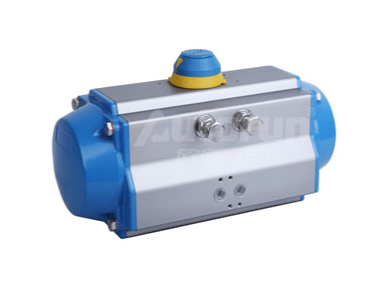Pneumatic actuator is an actuator driven by pneumatic force to open and close or regulate valves. It is also called pneumatic actuator or pneumatic device, but it is commonly called pneumatic head. The actuating mechanism and regulating mechanism of pneumatic actuator are unified as a whole. The actuating mechanism of pneumatic actuator includes film type, piston type, fork type and gear rack type.
The piston stroke is long and suitable for situations requiring greater thrust, while the membrane stroke is small and can only drive the valve stem directly. Pneumatic fork actuator has the characteristics of large torque, small space, torque curve more in line with the torque curve of the valve, but it is not very beautiful; it is commonly used in large torque valves. The rack-and-pinion pneumatic actuator has the advantages of simple structure, stable and reliable operation, and safety and explosion-proof. It has been widely used in power plants, chemical industry, oil refining and other production processes with high safety requirements.

Selection of Pneumatic Actuator
Before choosing pneumatic actuator, please confirm the valve torque. The safety value is increased by 25% for water vapor or non-lubricated liquid medium and 30% for non-lubricated slurry liquid medium.
The selected valve has a torque of 210 NM, a gas pressure of only 5 bar and a medium of non-lubricated water vapor. Considering the safety factors, the safety value of 262 NM is increased by 25%. The corresponding torque value of the gas pressure at 5 bar is found by the double-acting output torque table. 277NM model POADA300 should be selected.
Pneumatic actuator
Performance characteristics of pneumatic actuator
1. The rated output force or moment of the pneumatic device shall comply with the requirements of GB/T12222 and GB/T12223. The film actuator shall be on the top.
2. In the case of no-load, when the air pressure is input into the cylinder according to the stipulation, the action should be stable, without obstruction and creeping phenomenon.
3. Under the air pressure of 0.6 MPa, the output torque or thrust of the pneumatic device in the opening and closing directions should be no less than the value indicated by the pneumatic device sign, and the action should be flexible. Permanent deformation and other abnormal phenomena should not be allowed in all parts.
4. When the maximum working pressure is used in the sealing test, the amount of air leaked from each side of the back pressure should not exceed (3+0.15D) cm3/min (standard state); the amount of air leaked from the end cap and output shaft should not exceed (3+0.15d) cm3/min;
5. Strength test is carried out under the maximum working pressure of 1.5 times. Leakage and structural deformation are not allowed in the end cap and static sealing parts of the cylinder block after keeping the test pressure for 3 minutes.
6. Operating life times, pneumatic device simulates pneumatic valve action, while maintaining the output torque or thrust capacity in two directions, the number of opening and closing operations should not be less than 50,000 (opening-closing cycle is one);
7. When the piston moves to the end of the stroke, the impact phenomenon is not allowed in the pneumatic device with buffer mechanism.


























